
|   |

|   |
Rasabilasa 2025: A celebration of indian classical dance - Dr. Nita Vidyarthi e-mail: nitavidyarthi@gmail.com Photographs courtesy: Arijit Roy, and Tarun Bose March 12, 2025 Kolkata's premiere Odissi training and performance institution Srijan Chhanda, spearheaded by Odissi dancer Rajib Bhattacharya, organised a fascinating evening offering a short glimpse into some selected Indian classical dance forms as well as a martial art form of Bengal at the Gyan Manch, Kolkata. The recent increasing trend for duets with dancers from two different classical dance styles, is in a big way a healthy sign leading to the creative expansion of the arts. It facilitates as well as displays the ability and training of the dancers, in understanding the nuances of each other's forms simultaneously offering an assessment of the depth of their technical knowledge to present an item, matching with each other seamlessly while adapting to the demands of the stage and reinventing themselves without losing their basic identities. Conceptualized by Rajib, 'Rasabilasa' was therefore to soak into and appreciate the rasa of each other's dancing. The evening commenced with the inauguration and then Pushpanjali by distinguished guests followed by the opening presentation "Jaya Jagadisha Harey" choreographed by Rajib Bhattacharya and performed by him and the students of Srijan Chhanda. Mangalacharan by Rajib was the shloka portraying the divine splendour of Lord Krishna. Set to the enchanting all-time favourite Sanskrit poem, "Kasturi tilakam lalaata pataley" is a part of the Sri Krishna Karnamrutham, a collection of bhakti poems by Bilva Mangalar, who belonged to the tradition of great devotees of Krishna from Kerala. Tuned with the Odissi music by Himanshu Sekhar Swain it was not the usual stereotyped one which the audience were accustomed to hearing. Also, its execution in the Odissi dance style made the number novel. 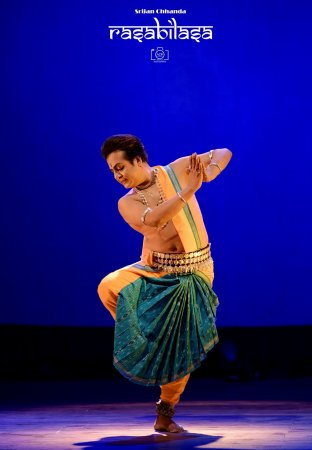 Rajib Bhattacharya A consummate dancer, Rajib did not paint every word of the lyrics of this beautiful composition literally. By abstracting the essence from the literary composition, to which he gave his own stylistic flavour through artistic manipulation of his hastas as well as body movements, he portrayed a fantastic Krishna with a perfect tribhanga. And his choreography still adhered to the Odissi vocabulary and transformed the lyrics into meaningful visual images adhering to the grammatical and technical logic of his Guru Ratikant Mohapatra and of the Guru Kelucharan Mohapatra gharana. This was observed to be so also in his subsequent group choreographic compositions where he transformed his vocabulary of movements into meaningful visual images. The essence of the shloka was elevated by the flow of impassionate facial expressions which moved with the singing while the dancing moved with Himanshu Swain's evocative music, illustrating and contrasting between ornamented God and God being the Supreme Ornament. It was blended seamlessly with the very popular mellifluous bhajan "Achyutam Keshavam Krishna Damodaram" and "Bhaja Govindam" (with jumping and clapping hands in ecstasy as in the kirtan traditions) to present a brilliant piece both in terms of dancing and in music. Such sophistication comes naturally and instinctively to this dedicated dancer who can not only bring out the fine variations in the kinetics of the feet in nritta but can also exercise his grip on any form of emotion or mood with his exhaustive training and understanding making his solo performances a rewarding experience. The students of Srijan Chhanda proved their good teamwork and solid training in the subsequent four numbers beginning with the rhythmic number "Chalo Brindavan hum sabkey taal sunandan". The mix of the haunting tune of the flute with the splash of choreography of the group of male and female dancers in this number was a sheer joy. With a seamless blend of classical and contemporary inputs, Rajib heads into new choreographic ideas with typical enthusiasm to welcome 'the Prince of seasons, Basant' with a recipe of jubilation with a group number set to "Lalita lavanga lataye jhumey chandana charu pavan se". It is the Hindi version of the timeless Kavi Jayadeva Ashtapadi "Lalita lavangalata parishilana" with the Hindi lyrics by none other than Pandit Jasraj. The number was sung by Mahalakshmi Iyer and Shreya Ghoshal and a smart chorus set to a refreshing mellifluous music. The imaginative choreography of the lines "Is Basant mein Giridhar vihare" (Biharati Haririha sarasabasantey nrityatiyuvatijanen..) with Rajib, clad in yellow, dancing as Krishna with two sakhis was paired with tunes that let emotion swirl the audience away. The delightful 4th verse (Ashtapadi)from the same Canto 1, "Chandana charchita neelakalebara pitabasana Banamali" was a stunning performance with Rajib as Banamali in a yellow costume smeared with sandalwood paste (Chandana charchita) reveling in the company of the damsels of Gopa as in the subsequent lines "Haririha mugdha vadhunikarey, bilasini bilasati keli parey" and "Chandana charchita neela kalebara" was enchanting yet artfully intriguing and captured the audience with their involved dancing. A scintillating and different presentation embellished with striking formations and use of the stage space by the skilled dancers shared, conceived and reconstructed by Rajib, their Guru. Another all-time favourite was the sweet 'Chandan Jatra' number "Dekho go Radha Madava chali" where Radha and Krishna travel in a palanquin to reach the festival. The fine visual imagery of the 'Jatra' (ride) was vivid with slow jerky dancing in tandem with the rhythm and to and fro movements (chalan) by the sakhis, hands folded upwards at 45 degree angle posing to hold the vehicle rods of the palanquin. Set to traditional tunes, with Rajib once again as Krishna, this was another entertaining number. 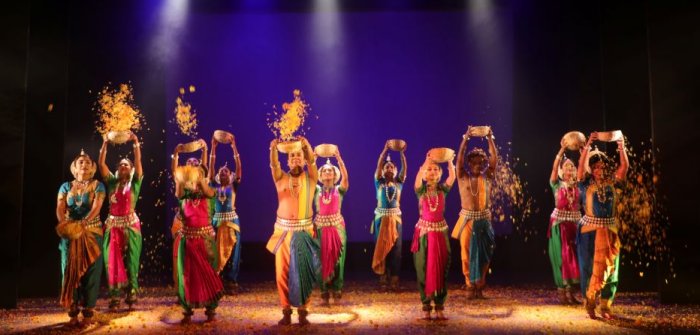 Srijan Chhanda Srijan Chhanda ushered in Spring and concluded their production "Jaya Jagadisha Harey" with joyful songs, mellifluous music, dazzling costumes, happiness and finally rejoiced the advent of Basant by showering flowers among themselves on stage and on the audience celebrating the arrival of Holi artfully with an effervescent ensemble loudly with "Jaya Jagadisha Harey" - "Hail O Hari, Lord of the Universe". 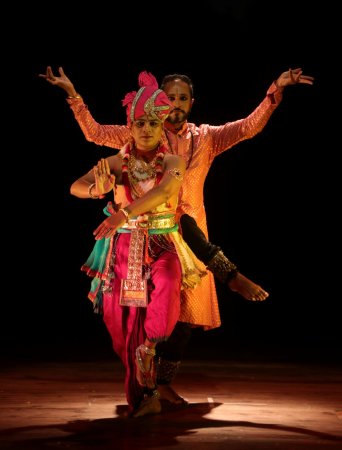 Sourav Roy and Sudip Ghosh After a short Guru Pranam, Sourav Roy in Kathak and Sudip Ghosh in Manipuri began their duet 'Tarana-Tanum' in their respective styles with a pure dance number. Sourav Roy moved on to an energetic recital of 'Tarana' and Sudip in Manipuri style in 'Tanum,' items composed of strong tandava elements. Both are seasoned dancers, but Sourav has a commanding stage presence with a fine erect bodyline as a result of which his chakkars were a pleasure to watch. His quick flourish of 'Amad' after the Thaat, projected his elegance, preparing the audience for a strong rhythmic footwork, smart tihais in his rendition of tatkaar with quickening of steps with the intricate rhythms and riveting chakkars. 'Tarana' is a delightful composition of rhythm, movement vocabulary and melody loaded together and Sourav did full justice to it drawing audience attention automatically. 'Tanum' was one of the complex and most beautiful items in Tandava composed by the legendary Manipuri maestro Guru Bipin Singh especially for the solo performers. Generally part of 'Nityaraas', this specialised item is popular now and is based on classical elements like Prabandhas and elaborate musical compositions inspired by the dignified movements of kartaal cholam as in the Natasankeertana in Rajmel taal and was a good choice to match a duet with tarana. While matching 'tanum' with Sourav's execution especially in terms of rhythms, Sudip proved his solid training with a complete angahara. Dressed in a shimmering costume of Lord Krishna complete with the stunning headgear, Sudip won the hearts of the audience with his exuberant spins in the air, vigorous jumps and Bagleiba (moving turning around on the floor round the knees) so characteristic of male dancers especially in cholams with pung and large drums. To watch the two dancers harmonising together especially with their rhythmic skills was overall a pleasing experience. 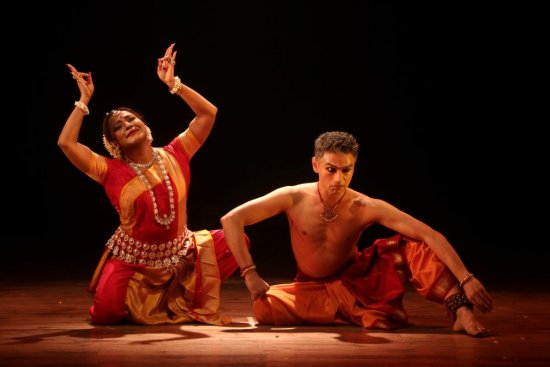 Sayomita Dasgupta and Samrat Dutta Already well-known names, Odissi dancer Sayomita Dasgupta and Bharatanatyam dancer Samrat Dutta have carved a niche for themselves in their respective fields with their individual performances and have proved their exhaustive training in their presentations while transforming them to the audience. Here they were in two striking duets in two different styles with flawless technical delivery of either forms with no rough edges either in matching talas in the nritta or in the abhinaya piece. As an invocation, the Dhyana mantra "Singhasta sashishekhara marakata prakhyaishsra chaturbhirbhujai" on "Chaturbhuja Durga, Katyayani Devi" (the 6th appellation of Goddess Durga) was an uncommon performance text. A warrior goddess associated with the fierce form of Shakti or Durga who is worshipped on the sixth day of Navaratri, Katyayani is the second name given to the Mother Goddess Adi Parashakti in Amarakosha, the Sanskrit lexicon. Goddess Durga is believed to get the power from Katyayani and appears as Katyayani to kill Mahishasura. So, Katyayani is also known as Mahishasuramardini. While most performances concentrate on Dasabhuja Durga, this was a welcome choice for a change and quite enriching. The invocation commenced with a stunning imagery of the two dancers standing back to back centre-stage with raised anjali hastas rotating gently on the same vertical axis, under the spotlight on them from the ceiling of the dark stage with music set to raag Bhairavi and tala adi. Both are seasoned dancers and the duet saw them in an exalted form .While Sayomita's graceful performance flowed with through an elaboration of Odissi vocabulary of already familiar steps of the Guru Kelucharan Mohapatra gharana, with the shloka, Samrat with his powerful adavas adapting a linear geometry was true to his guru Professor C.V. Chandrashekhar's training with the rhythm, both being sincere to their respective styles. The succession of dancing to the final stance of Katyayani slaying Mahishasura with the trident, though a very common posture, was praiseworthy. A padam collected from the "Tamil Ramanatakam" on the well-known vengeful conversation of Manthara and Queen Kaikeyi episode from the regional Ramayana, prior to the "Rama Pattabhishekam" (coronation) for which Ramachandra was exiled, was a stimulating performance with an ambivalence of dance drama and theatre. The abhinaya began with the shloka "Ramaya Ram bhandraya Ramchandraya vedhase" where Sayomita (Kaikeyi) expresses her happiness at Ram's Pattabhishekam. Then scheming Manthara starts advising her and finally succeeds in achieving her mission of making Bharat the King of Ayodhya and send Ram to exile. Sayomita performed with her usual ease and competence but Samrat ruled the stage first with his strong dancing with athletic movements, then with his gait and sitting postures of an old women and finally fascinated all with his facial expressions, twitches of lips, eyebrows and eyes and facial muscles, portraying a malicious, revengeful Manthara, full of hatred, feeling happy with the success of her evil, harmful plot. Both the dancers showed their fine communication and understanding in nritya and natya, for facilitating theme enrichment till the climax. This abhinaya piece was a successful duet to bring out the rasanubhuti - to be seen again and again. Mridangam player Shankar Narayanaswamy's music composition in raga Abhogi, talam adi and lights by Soumen Chakravarty enhanced the appeal of the duet.  Subrata Pandit and Subikash Mukherjee The next performance was an amazing Kathak-Odissi duet by seasoned dancers Subrata Pandit in Kathak and Subikash Mukherjee in Odissi. They commenced with Tarana - Pallavi in raga Behag, tala Triputa, an intricate rhythm and melody based pure dance item. Their stress lay on creative wizardry of rhythms in recitals of Tatkaar by Subrata in Tarana and the complexity of intricate padachalana by Subikash in Pallavi. Both were in perfect sync and harmony with speed and flawless technical delivery. This item gave the audience a glimpse of the dancers' forte - a strong, clear and highly skillful footwork. Claimed to be exploring the mystical depths of Sufi philosophy, (Subrata changed his costume to white georgette kurta-pyjama for this item), their next abhinaya piece was set to the chartbuster "O rangrez tere rangdariya mein" sung by the celebrated Shreya Ghoshal and Javed Bashir with mesmerizing music by Shankar - Ehsan-Loy from the hit film 'Bhaag Milkha Bhaag'.While the dancers responded to the rhythm of the music, the reflection of 'Sufi philosophy' was hardly perceptible. The final stance with the line "Nahin rehna duja banke" was yet another 'freeze' of the two dancers standing back to back with folded hands. 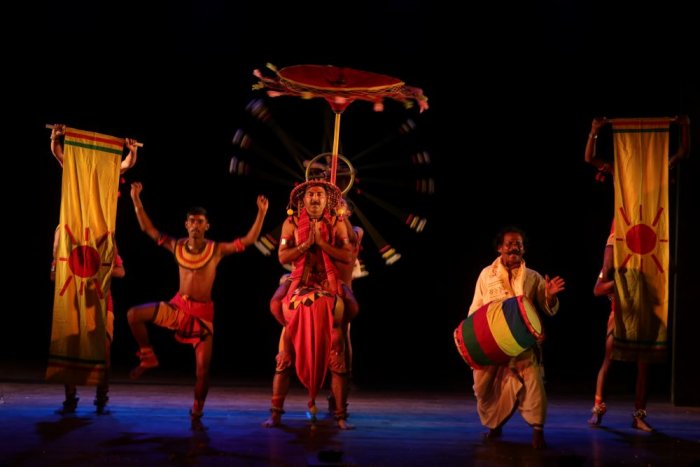 Raibenshe The show stealers of the evening was Raibenshe, the martial arts from Bengal presented by the male repertory members of Sarabhuj Dance Theatre under the guidance of its Founder-Director and artistic choreographer Dr. Tarun Pradhan. An internationally renowned and foremost artist and performer of traditional folk dance and drama of Bengal, Dr Pradhan, an Associate Professor of Rabindra Bharati University, is a pioneer in reviving this age-old art. He, with his team, has been playing a great role in promoting and propagating rare traditional dance and theatre and body movement. Initially trained by erstwhile Zamindars in Birbhum district of Bengal some hundred years ago, men as their bodyguards, practised different physical movements and mock fights with long, sturdy bamboo sticks (lathi) to keep themselves fit. Wearing ankle bells with sticks in their hands they exercised and performed acrobatics with the accompaniment of percussion instruments like dhol, mardal, and large brass cymbals. Raibeshe or Raibenshe is practised by male members only and at present only in districts of Birbhum, Bardhaman and Murdhidabad. Dr. Pradhan's male members of Sarabhuj gave a glimpse of that practice on stage for forty five minutes, sweeping off the audience, leaving them spellbound. The performance started with the entry of ten bare bodied men, wearing tightly fitted dhotis with sticks in their hands, some with swords and shields, with a loud howl, running into the stage and then encircling it in slow motion (like in Bratachari dances) as if trapping an enemy. A lightning recall of memory was the Chakravihu of Abhimanyu by the Kauravas! Presentations with different acrobatic moves, somersaults, cartwheels Baghleiba, formations like pyramids with multiple men entwined with one another or on top of another in tiers, rotating a wheel were with the accompaniment of live music of flute, dhol and dhamsa (oversize drum). The unbelievably agile and fit performers made it clear that movement is a vast communicating language and that varieties of combinations of physical elements constitute thousand "movement words". Dr. Pradhan dealt with three intangible elements: movement, time and space to transform his vocabulary into wonderful, awestriking, visual images. The bright, vibrant finale was of unique flavour. Although ghungroos were used, it was not dance in the conventional way but was an entertainment and experience where the director, through artistic manipulation gave a realistic, masculine physical representation of movements, to communicate literal meaning. The musicians Shaktipada Maity, Phatik Midha and Paritosh Mridha gave able support to the unforgettable production directed by Dr. Tarun Pradhan. 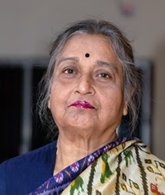 Dr. Nita Vidyarthi is a veteran critic of performing arts and writes on dance, music and theatre in leading publications. |